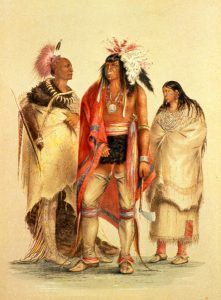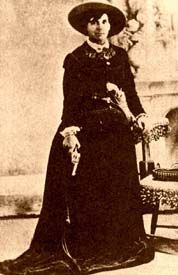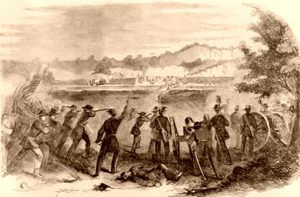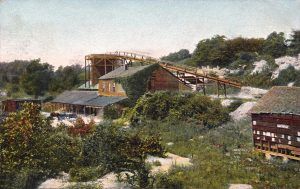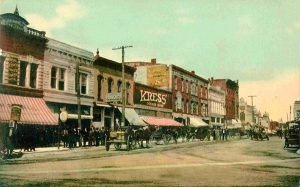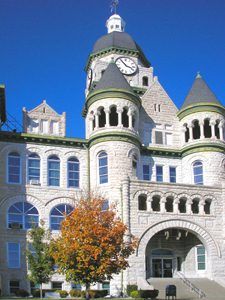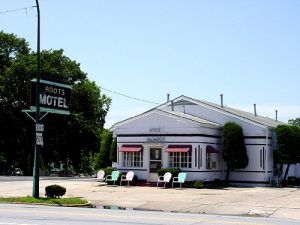Carthage, Missouri, is the county seat of Jasper County and one of the many Route 66 cities along its historic path. It is nicknamed “America’s Maple Leaf City.”
The territory that would one day become Jasper County, Missouri, was purchased by the U.S. Government from the Osage Indians in 1808 for $1,200 in cash and $1,500 in merchandise. The Native Americans were then moved to an area designated as the Osage Nation. Though many tried to return to their native lands in 1837, they were soon driven back to their territory.
Jasper County was formed in 1841 with a 12’x16′ split log house on a bluff above Spring River, designated as the first county seat. The newly formed government required each white male to help build the public roads through the county at least two days per year or pay a 50-cent tax. A year later, the county adopted the site of Carthage as the permanent county seat and laid out the new townsite surrounding a public square. On the square’s north side, a simple one-room frame courthouse was built at a cost of $398.50, completed in June 1842. Other frame buildings soon followed, housing Carthage’s first businesses. By 1851, the prospering little town had outgrown its small wooden courthouse, and a two-story brick structure replaced the building.
In 1856, John Shirley, the father of the notorious would-be outlaw “Bandit Queen,” Belle Starr, moved his family from his nearby farm to Carthage, where they built an inn, a tavern, a livery stable, and a blacksmith shop on the north side of Carthage’s courthouse square. Their businesses took up almost an entire city block, and John Shirley became a respected member of the burgeoning county seat of Carthage. Though Belle was raised with the life of a spoiled, rich girl, that life would change when the Kansas-Missouri Border War broke out.
In 1854, the Kansas–Nebraska Act opened up the new state of Kansas, allowing its residents to decide on the question of slavery.
Having strong southern sympathies, the state of Missouri quickly became embroiled in a bitter fight with the newly settled anti-slavery groups that populated the new state.
The border towns in both states quickly became the sites of fierce guerilla warfare in the Kansas-Missouri Border War, which prefaced the Civil War by more than six years. Carthage was no exception to the bitter fighting between the two factions. In fact, on July 5, 1861, the first large-scale engagement of the Civil War took place in Carthage, when 6,000 poorly equipped Missouri State Guardsmen held off 1,100 Union Soldiers. Both sides declared victory and would meet up again a month later at Wilson’s Creek.
Jasper County watched both armies pass through repeatedly, forcing residents to take sides and making neighbors into bitter enemies. Irregular bands of “Jayhawkers” and “Red Legs” laid waste to Missouri communities in support of the Union.
When Belle Starr’s brother, Bud, joined Quantrill’s Raiders, John Shirley was a proud father. But in June 1864, Bud was killed in Sarcoxie, Missouri. The raids had taken their toll on Shirley’s businesses, and after Bud’s death, the family gave up and moved to Texas. It was in Texas that Belle began her notorious outlaw career.
The battles preceding the Civil War and the following skirmishes destroyed the small settlement of Carthage. Though its courthouse continued to serve until 1863, it was destroyed by fire in the ravages of war. Soon, all of Carthage’s 500 residents had joined the war efforts or moved away from the war-torn town.
By 1868, Carthage had grown to a population of 1,200 and boasted a school, four churches, three doctors, two hotels, five boarding houses, six dry good stories, five grocery stores, and scores of other businesses. Continuing to grow, Carthage was called home to some 6,000 people by 1873, adding several industries, including a woolen mill, two foundries, three wagon and carriage makers, a furniture factory, and a wealth of other businesses.
In the late 1880s, Carthage discovered rich deposits of limestone, lead, and zinc beneath the town and surrounding area. Through these gifts from the earth, Carthage soon became one of the most prosperous towns in the state and was called Queen City of the Southwest by the 1890s.
The cornerstone of the present Courthouse was laid in August 1894 and was completed in 1895 for $100,000.
After the Civil War came the Wild West days, and Carthage’s new courthouse became the site of many public hangings. According to old-timers, these events were public spectacles where vendors set up booths and sold food and trinkets. The gallows, built right upon the courthouse grounds, became the “stage” for many viewers who brought their lunches and enjoyed a picnic during the show.
This magnificent structure remains in use today.
By the end of the 19th century, Carthage had more millionaires per capita than any other city in the United States. The primary source of the wealth was the rich deposits of lead and zinc, and soon, the mine owners began to build fine homes in Carthage. Huge deposits of gray marble at the north edge of Carthage provided another source of prosperity. The Missouri State Capitol, U.S. Capitol, and White House are faced with marble from the Carthage area.
Yet more mills and factories began in the thriving rebuilt city. By 1900, Carthage had approximately 12,000 inhabitants and over one hundred business and industrial concerns.
When Route 66 was built through the town, Carthage was soon proclaimed by its Chamber of Commerce as “The Open Gate to the Ozarks.” In no time, all manner of services began to spring up to serve the many travelers of the Mother Road.
As you travel through Carthage, you will see the Powers Museum, located on the first alignment of Route 66 on Carthage’s west side, along with Municipal Park, which was developed during the 1930s thanks to several New Deal programs. This site was once home to the Taylor Tourist Park, later renamed the Park Motor Court and Café.
As Route 66 winds its way through Carthage, the Town Square, including its 1894 courthouse, is home to many historic buildings.
About a block from the Town Square, at the intersection of Missouri Highway 71 and Route 66, is a “must-see” along your trek through Carthage — the historic Boots Court Motel. Built as a tourist court in 1939 by Arthur Boots, this popular stop along the old Mother Road once advertised a radio and every room, and Clark Gable reportedly stayed in Room 6. The Boots Motel is a classic example of streamlined architecture popular during this era.
Across from the Boots Motel once stood the Boots Drive-in, which offered fountain service and “Breakfast at any hour!” The drive-in thrived throughout the 1940s but declined after the Interstate bypassed Carthage and closed in 1971. However, the building was preserved and today is utilized as a bank.
One block north of the Boots Motel stands the remains of another old tourist court – the Dazy Apartments and Sleeping Rooms. While it is evident that the Dazy has seen much better days, it still appears to remain in use today.
Carthage is also home to one of America’s few surviving drive-in theaters. Thanks to the efforts of Mark and Dixie Goodman, this old drive-in has not gone the way of most of these old icons. When the Goodmans bought the historic drive-in, it was in much disrepair; however, they brought this old theatre back to life.
Just before you reach Webb City, you will pass through the small town of Carterville, another lead mining town in the region. Once prosperous, the town declined following World War I and never recovered like its neighbors of Webb City and Joplin.
© Kathy Alexander/Legends of America, updated April 2024.
Also See:
Bleeding Kansas and the Missouri Border War


